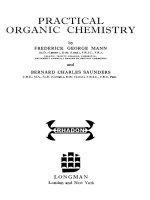Organic chemistry (2)
Bạn đang xem bản rút gọn của tài liệu. Xem và tải ngay bản đầy đủ của tài liệu tại đây (1.96 MB, 74 trang )
Organic
Chemistry
William H. Brown
Christopher S. Foote
Brent L. Iverson
1-1
Covalent
Bonding &
Shapes of
Molecules
Chapter 1
1-2
Organic Chemistry
The study of the compounds of carbon
Over 10 million compounds have been identified
• about 1000 new ones are identified each day!
C is a small atom
• it forms single, double, and triple bonds
• it is intermediate in electronegativity (2.5)
• it forms strong bonds with C, H, O, N, and some metals
1-3
Schematic View of an Atom
• a small dense nucleus,
diameter 10-14 - 10-15 m,
which contains positively
charged protons and
most of the mass of the
atom
• an extranuclear space,
diameter 10-10 m, which
contains negatively
charged electrons
1-4
Electron Configuration of Atoms
Electrons are confined to regions of space called
principle energy levels (shells)
• each shell can hold 2n2 electrons (n = 1,2,3,4......)
N u mb er of
Relative En ergies
Electrons S hell
of Electrons
S hell
Can Hold
in Thes e Shells
h igh er
4
32
3
18
2
8
1
2
low er
1-5
Electron Configuration of Atoms
Shells are divided into subshells called orbitals,
which are designated by the letters s, p, d, f,........
• s (one per shell)
• p (set of three per shell 2 and higher)
• d (set of five per shell 3 and higher) .....
S hell
O rb itals Contain ed in Th at S hell
3
3s , 3p x , 3p y , 3p z, p lu s five 3d orbitals
2
1
2s , 2p x , 2p y , 2p z
1s
1-6
Electron Configuration of Atoms
Aufbau Principle:
• orbitals fill in order of increasing energy from lowest
energy to highest energy
Pauli Exclusion Principle:
• only two electrons can occupy an orbital and their
spins must be paired
Hund’s Rule:
• when orbitals of equal energy are available but there
are not enough electrons to fill all of them, one
electron is added to each orbital before a second
electron is added to any one of them
1-7
Electron Configuration of Atoms
The pairing of electron spins
1-8
Electron Configuration of Atoms
Table 1.3 The Ground-State Electron
Configuration of Elements 1-18
1-9
Lewis Dot Structures
Gilbert N. Lewis
Valence shell:
• the outermost occupied electron shell of an atom
Valence electrons:
• electrons in the valence shell of an atom; these
electrons are used to form chemical bonds and in
chemical reactions
Lewis dot structure:
• the symbol of an element represents the nucleus and
all inner shell electrons
• dots represent valence electrons
1-10
Lewis Dot Structures
Table 1.4 Lewis Dot Structures for Elements 1-18
1A
2A
3A
4A
5A
6A
H.
Li .
.
Be :
N a. M g :
B:
.
Al:
.
.
.
.
.
C : . N : : O. :
Si : . P :
7A
8A
He :
:
.
:F
: : :N: e :
:
:S : :Cl
: : :A: r :
.
.
.
1-11
Lewis Model of Bonding
Atoms bond together so that each atom acquires
an electron configuration the same as that of the
noble gas nearest it in atomic number
• an atom that gains electrons becomes an anion
• an atom that loses electrons becomes a cation
• the attraction of anions and cations leads to the
formation of ionic solids
• an atom may share electrons with one or more atoms
to complete its valence shell; a chemical bond formed
by sharing electrons is called a covalent bond
• bonds may be partially ionic or partially covalent;
these bonds are called polar covalent bonds
1-12
Electronegativity
Electronegativity:
• a measure of an atom’s attraction for the electrons it
shares with another atom in a chemical bond
Pauling scale
• generally increases left to right in a row
• generally increases bottom to top in a column
1-13
Formation of Ions
A rough guideline:
• ions will form if the difference in electronegativity
between interacting atoms is 1.9 or greater
• example: sodium (EN 0.9) and fluorine (EN 4.0)
• we use a single-headed (barbed) curved arrow to show
the transfer of one electron from Na to F
Na
+
•• ••
F
••
Na+
• • • • •-
F
••
• in forming Na+F-, the single 3s electron from Na is
transferred to the partially filled valence shell of F
N a(1s 22s 22p 63s 1 ) + F(1s 22s 2 2p5 )
N a+ (1s 2 2s 22p 6) + F- (1s 2 2s 2 2p6 )
1-14
Covalent Bonds
The simplest covalent bond is that in H2
• the single electrons from each atom combine to form
an electron pair
H•
+
•H
H-H
∆Η 0 = −435 κϑ (−104 κχαλ)/µ ολ
• the shared pair functions in two ways simultaneously;
it is shared by the two atoms and fills the valence shell
of each atom
The number of shared pairs
• one shared pair forms a single bond
• two shared pairs form a double bond
• three shared pairs form a triple bond
1-15
Polar and Nonpolar Covalent Bonds
Although all covalent bonds involve sharing of
electrons, they differ widely in the degree of
sharing
We divide covalent bonds into
• nonpolar covalent bonds
• polar covalent bonds
D i fference in
El ectron eg ati vity
Betw een Bo nded Ato ms
Less than 0.5
0.5 to 1.9
Greater than 1.9
Typ e of Bond
N on pol ar cov alent
Pol ar co valent
Io ns f orm
1-16
Polar and Nonpolar Covalent Bonds
• an example of a polar covalent bond is that of H-Cl
• the difference in electronegativity between Cl and H is
3.0 - 2.1 = 0.9
• we show polarity by using the symbols δ + and δ -, or
by using an arrow with the arrowhead pointing toward
the negative end and a plus sign on the tail of the
arrow at the positive end
δ+
H
δCl
H
Cl
1-17
Polar Covalent Bonds
Bond dipole moment (µ ):
• a measure of the polarity of a covalent bond
• the product of the charge on either atom of a polar
bond times the distance between the nuclei
• Table 1.7 shows average bond dipole moments of
selected covalent bonds
Bond
Dipole
Bond (D )
Bond
Dipole
Bond (D )
Bond
D ipole
Bond (D)
H-C
H-N
H-O
H-S
C-F
C-Cl
C-Br
C-I
C-O
C=O
C-N
-C=N
0.3
1.3
1.5
0.7
1.4
1.5
1.4
1.2
0.7
2.3
0.2
3.5
1-18
Lewis Structures
To write a Lewis structure
•
•
•
•
determine the number of valence electrons
determine the arrangement of atoms
connect the atoms by single bonds
arrange the remaining electrons so that each atom has
a complete valence shell
• show a bonding pair of electrons as a single line
• show a nonbonding pair of electrons as a pair of dots
• in a single bond atoms share one pair of electrons, in a
double bond they share two pairs of electrons, and in
a triple bond they share three pairs of electrons
1-19
Lewis Structures - Table 1.3
H-O-H
H 2 O (8)
Water
H
H
H-C-H
H
CH 4 (8)
M ethane
H-N-H
H
N H 3 (8)
Ammonia
H
C C
H
H
C2 H 4 (12)
Ethylene
H-Cl
HCl (8)
H ydrogen chloride
O
H
H-C C-H
C O
C 2H 2 (10)
Acetylene
H
CH 2O (12)
Formaldehyde
H
O
C
O
H
H 2CO 3 (24)
Carbonic acid
In neutral molecules
•
•
•
•
•
hydrogen has one bond
carbon has 4 bonds and no lone pairs
nitrogen has 3 bonds and 1 lone pair
oxygen has 2 bonds and 2 lone pairs
halogens have 1 bond and 3 lone pairs
1-20
Formal Charge
Formal charge: the charge on an atom in a
molecule or a polyatomic ion
To derive formal charge
1. write a correct Lewis structure for the molecule or ion
2. assign each atom all its unshared (nonbonding)
electrons and one-half its shared (bonding) electrons
3. compare this number with the number of valence
electrons in the neutral, unbonded atom
Formal
charge
N umber of
= valence electrons
in th e neutral,
un bonded atom
All
One h alf of
un shared + all sh ared
electrons
electrons
1-21
Formal Charge
Example: Draw Lewis structures, and show which atom in
each bears the formal charge
(a) NH2
(b) HCO3
(c) CO3
2-
+
(d) CH3 NH3
(e) HCOO
(f) CH 3 COO
1-22
Exceptions to the Octet Rule
Molecules containing atoms of Group 3A
elements, particularly boron and aluminum
B
Boron trifluoride
:Cl
Al
:Cl :
:
:
:F :
:Cl :
: :
: :
:F
6 electrons in the
valence shells of boron
and aluminum
:
:
:F:
Aluminum chloride
1-23
Exceptions to the Octet Rule
Atoms of third-period elements have 3d orbitals
and may expand their valence shells to contain
more than 8 electrons
• phosphorus may have up to
: 10
:
CH3 -P- CH3
CH3
Trimethylphosphine
: Cl : :
:
: Cl
:
Cl
: :
P
:
:
Cl
: Cl
:
: :
Phosphorus
pentachloride
:O:
:
:
H- :O-P- O-H
:
O-H
:
Phosphoric
acid
1-24
Exceptions to the Octet Rule
• sulfur, another third-period element, forms
compounds in which its valence shell contains 8, 10,
or 12 electrons
:
H- S: H
: O:
CH 3 - S: CH 3
: O:
:
:
H-O: S- O: H
:O :
Hydrogen
sulfide
Dimethyl
sulfoxide
Sulfuric
acid
1-25









